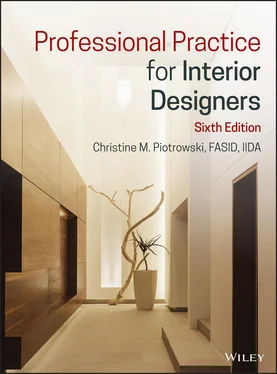Christine M. Piotrowski - Professional Practice for Interior Designers
Здесь есть возможность читать онлайн «Christine M. Piotrowski - Professional Practice for Interior Designers» — ознакомительный отрывок электронной книги совершенно бесплатно, а после прочтения отрывка купить полную версию. В некоторых случаях можно слушать аудио, скачать через торрент в формате fb2 и присутствует краткое содержание. Жанр: unrecognised, на английском языке. Описание произведения, (предисловие) а так же отзывы посетителей доступны на портале библиотеки ЛибКат.
- Название:Professional Practice for Interior Designers
- Автор:
- Жанр:
- Год:неизвестен
- ISBN:нет данных
- Рейтинг книги:4 / 5. Голосов: 1
-
Избранное:Добавить в избранное
- Отзывы:
-
Ваша оценка:
- 80
- 1
- 2
- 3
- 4
- 5
Professional Practice for Interior Designers: краткое содержание, описание и аннотация
Предлагаем к чтению аннотацию, описание, краткое содержание или предисловие (зависит от того, что написал сам автор книги «Professional Practice for Interior Designers»). Если вы не нашли необходимую информацию о книге — напишите в комментариях, мы постараемся отыскать её.
Professional Practice for Interior Designers
Professional Practice for Interior Designers — читать онлайн ознакомительный отрывок
Ниже представлен текст книги, разбитый по страницам. Система сохранения места последней прочитанной страницы, позволяет с удобством читать онлайн бесплатно книгу «Professional Practice for Interior Designers», без необходимости каждый раз заново искать на чём Вы остановились. Поставьте закладку, и сможете в любой момент перейти на страницу, на которой закончили чтение.
Интервал:
Закладка:
Permitting statutes: allow interior designers to submit plans for building permits. There is no jurisdictional oversight.
In most cases, the purpose of licensing legislation is to ensure the health, safety, and welfare of the public that hires interior designers, as well as the general public that uses interiors designed by a professional interior designer. Licensing and registration laws help the general public determine what level of professional is appropriate for their needs. For example, not all projects require the preparation of working drawings, and thus the client may not need a licensed professional to do the work.
These laws are enacted to establish minimum standards of competency of any individual who wishes to practice or engage in interior design activities as defined by the legislation within the jurisdiction. Legislation does not regulate the creative activity of interior design.
Where licensing legislation exists, an added tool of enforcement and redress exists for clients. Because legislation seeks to ensure that only competent practitioners offer design services or call themselves by a regulated title, a client can ask the jurisdiction's board of registration to investigate, and even fine and/or discipline the designer, if something goes wrong.
The two most common types of legislation are title acts and practice acts. Title acts restrict the use of the designated title to only those who meet the qualifications of the jurisdiction title act. Interior designers who meet these qualifications must also register with a jurisdiction agency or board. An individual who does not meet the qualifications of the title act may not use the title, for example, “interior designer” in any of his or her business dealings. With title registration, the title of interior designer connotes to the public that the individual has met the highest standards of the profession and can thus provide the most competent service to the consumer. These standards are related to education, experience, adherence to a code of conduct, and passing a qualifying examination.
Practice acts are much more stringent, as they limit what an individual can or cannot do in the practice of a profession in a particular jurisdiction. If a jurisdiction has a practice act, individuals cannot engage in any of the activities defined by the act unless they meet the qualifications established by a specific board of the jurisdiction and become licensed.
Practice acts are commonly legislated for professions that have an impact on the health and safety of the public. Lawyers, doctors, architects, and engineers have had to meet state practice act regulations for many years. Practice acts definitely limit who may practice a profession, and they usually require that individuals meet very stringent qualification criteria. When a person enters into a contractual relationship with an unlicensed professional, the contract may or may not be enforceable, depending on the statutes in the individual jurisdiction.
Those working under the supervision of a licensed interior designer in a jurisdiction with a practice act do not themselves need to be licensed. However, when a designer decides to work for herself or has her own business, then the designer must become licensed. In some jurisdictions, those who only design residences are exempt from licensing requirements.
States or provinces generally have a board of technical registration or board of registration—or some other titled group operated by the jurisdiction—to oversee professional registration of any kind. A jurisdiction board also oversees contractors, architects, and many other professions. The intent of legislation, however, is to indicate to the consumer which individuals have met the specific criteria related to education and work experience, indicating that those individuals have acquired professional competence in the field. Licensing or title registration legislation also provides a definitive measure of experience and educational preparation for those who practice interior design. Licensing protects the consumer from unregulated practice by those who do not have proper educational background, training, and experience in the profession of interior design.
Those who have been actively engaged in bringing licensing legislation to their state or province would all agree that it has not been an easy task—nor will it be in the future. Despite the frustration of many years of struggling with legislators and those who would rather that interior design not be licensed, many states in the United States have passed some type of interior design legislation. In 1982, Alabama became the first state to pass a title registration act. In 2001, Alabama successfully converted its title act to a practice act to become the sixth jurisdiction (at the time of this writing) to have a practice act. Many other states continue to work on legislation for either title registration or practice acts.
Readers may wish to contact their state or provincial coalition or the Government and Public Affairs Department of ASID, the Legislative Issues Committee of IIDA, or the national offices of other professional associations for information on legislation within their jurisdiction.
Whether one works toward licensing through title registration or practice acts, interior design professionals and students must be prepared to accept the ethical and legal responsibilities that such recognition brings. Chapter 7discusses the ethics and codes of conduct, and Chapter 8discusses the many legal responsibilities that a practitioner faces.
PROFESSIONAL ASSOCIATIONS
Professional associations have existed, in one form or another, since the early days of the interior design profession. This section begins with a brief history of professional associations for interior designers.
In some ways, the large associations that we know today began as local clubs focusing on the needs of decorators within a small geographic area. By the late 1920s, many local decorators' clubs had been started. The New York Decorators' Club is credited with being one of the first.
In many respects, these early clubs functioned more as social clubs than as groups focusing on professional education and standards. Standards for membership existed, but they varied from one group to another.
The first national association was the American Institute of Interior Decorators (AIID), established as part of the proceedings of the 1931 furniture market and show in Grand Rapids, Michigan. William R. Moore was elected the first AIID national president. In 1936, the organization moved its headquarters from Chicago to New York City and changed its name to the American Institute of Decorators (AID). Over the years, education and work experience requirements for membership changed and became more stringent.
In 1957, a group belonging to the New York branch of AID broke off and formed the NSID. For many years, disagreements over qualifications, testing, and terminology continued between the two organizations. In 1961, the American Institute of Decorators became the American Institute of Interior Designers (AID). Finally, in 1975, the American Institute of Interior Designers and the NSID overcame their differences and merged into one national organization, the ASID. Norman de Haan, FASID, took office as the first ASID national president.
In the late 1960s, the Institute of Business Designers (IBD) was incorporated to meet the needs of the commercial/contract designer. Charles Gelber was elected the first IBD president in 1970. IBD was conceived in 1963 by members of the National Office Furnishings Association (NOFA), who were concerned about the quality of interior design service in office furnishings dealerships. In 1963, NOFA‐d (NOFA‐designers) was formed to accommodate interior designers who were working for office furnishings dealers.
Читать дальшеИнтервал:
Закладка:
Похожие книги на «Professional Practice for Interior Designers»
Представляем Вашему вниманию похожие книги на «Professional Practice for Interior Designers» списком для выбора. Мы отобрали схожую по названию и смыслу литературу в надежде предоставить читателям больше вариантов отыскать новые, интересные, ещё непрочитанные произведения.
Обсуждение, отзывы о книге «Professional Practice for Interior Designers» и просто собственные мнения читателей. Оставьте ваши комментарии, напишите, что Вы думаете о произведении, его смысле или главных героях. Укажите что конкретно понравилось, а что нет, и почему Вы так считаете.












